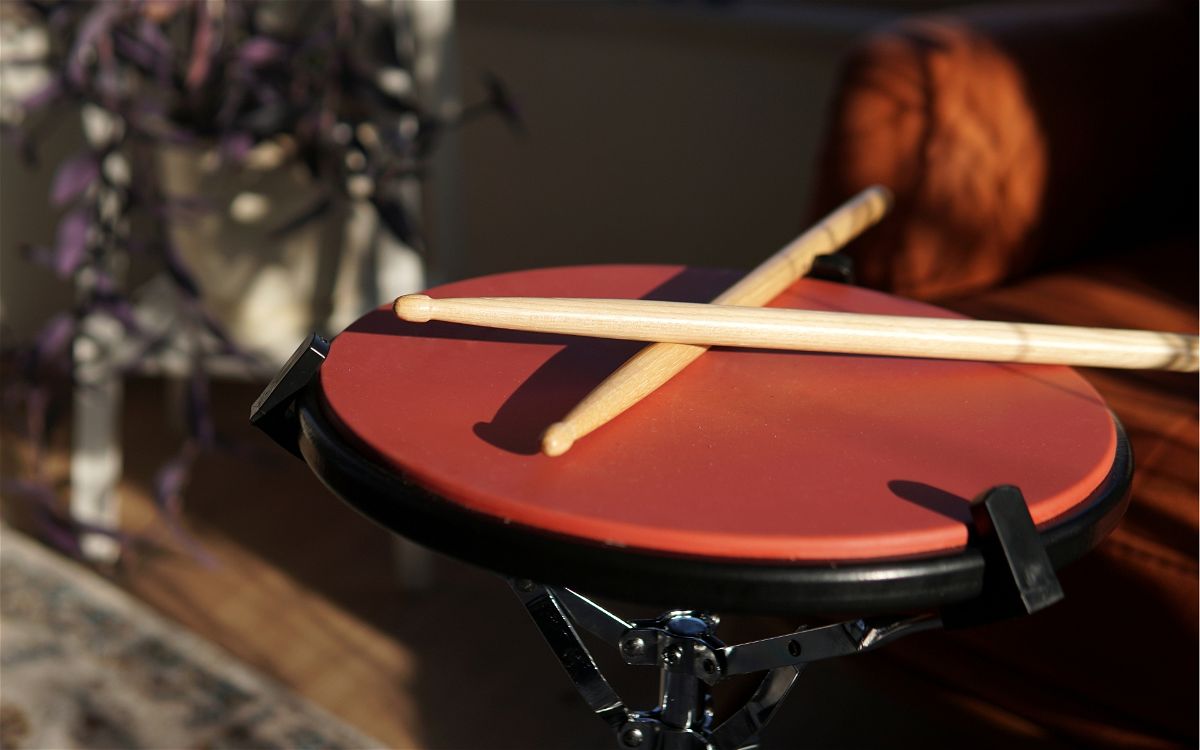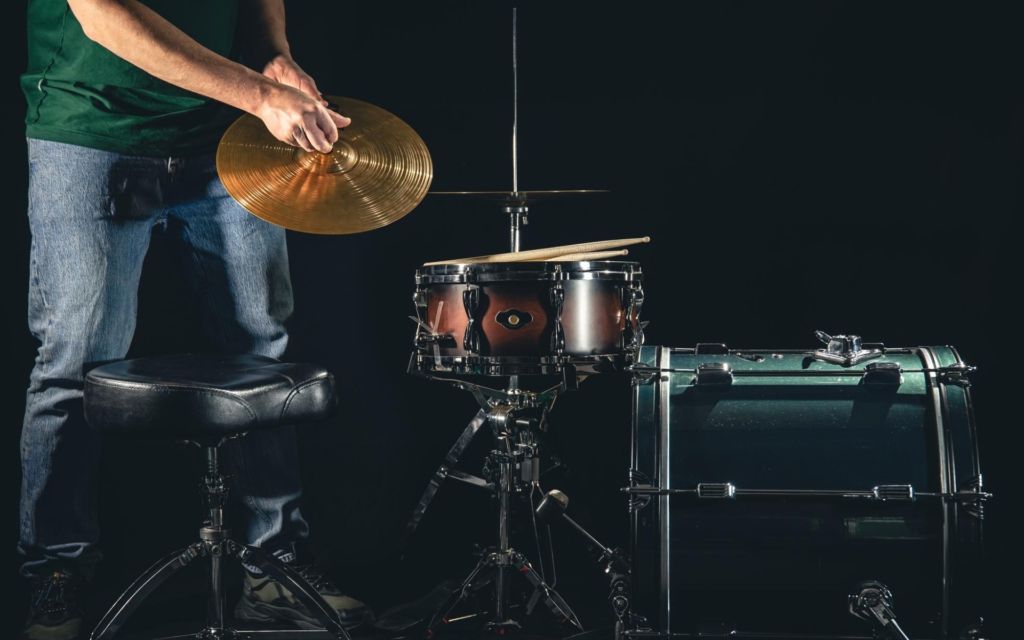Drum kits are one of the biggest instruments out there, meaning you need to have plenty of open space to own one. It’s understandable that not everyone has that option, especially when living in small apartments.
However, did you know that you can easily practice drums without a drum kit? It’s not ideal, but it’s your only option until you’re able to get to a kit.
In this guide, I’ll explain everything there is to know about practicing without a drum set. I’ll offer some methods, as well as a few tips on getting better at the instrument.
Contents
Is It Possible to Improve without a Drum Kit?
Yes, it’s very possible to improve your drumming skills without being able to play on a kit. You just need to have a good amount of focus and discipline. You also need plenty of patience, knowing that you’ll eventually be able to play on acoustic drums and put all your practicing to the test.
However, you’re not likely to improve as quickly by not using a full drum kit. Practicing without drums is just a temporary solution until you can. The goal should always be to find a place where you can practice and play on a full kit.
How to Practice Drums Without a Drum Set
There are actually several ways of practicing drums without a kit. Some of them are more hands-on than others, but all the methods I’m about to mention are great ways of getting in some practice.
Practice Pad and Sticks
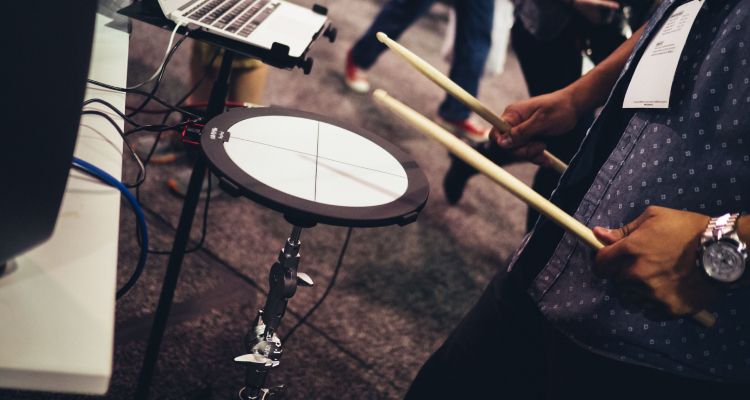
The main way of practicing drums without a drum set is by using a practice pad. You just need a good hand practice pad and a pair of drumsticks, and you’ll be good to go.
You can place the practice pad on a flat surface somewhere that allows you to sit or stand comfortably. Otherwise, you could put the pad on a snare drum stand to allow you to sit on a couch or chair.
Using a snare drum stand is better, as it allows you to control the height of the practice pad.
You also get kick drum practice pads that allow you to play bass drum patterns. They all require you to place a kick drum pedal on them.
With a hand and foot practice pad ready, you’ll be able to work on various different drumming skills. If you want to get even more elaborate, you could use multiple practice pads to create a small practice drum set.
A practice pad is one of the best quiet alternatives to playing a full-sized kit.
Work on Your Hand and Foot Techniques
If you’re wondering what specifically to work on with your practice pad setup, the best place to start is by refining your playing technique.
For your hands, focus on striking the practice pad in the center, and work on a combination of using your fingers, wrists, and both simultaneously.
For your bass drum foot, you could work on refining your striking technique. You can also learn to play important bass drum techniques like the slide of heel-toe. Those allow you to play quick consecutive doubles with just one foot.
You should also focus on how you sit at the practice pad setup. Make sure to keep a straight back, as you want good posture to transfer from here over to a real drum kit setup.
Rudiments
Once you have your techniques refined, you can use the practice pad setup to work on all your rudiments.
These are hand combinations and patterns that all drummers should know, as they’re the very foundation of most drumming ideas.
If you’re a beginner drummer, you should mainly focus on single strokes, double strokes, and paradiddles. Those three rudiments need to be mastered in order to feel comfortable playing drum fills around a kit.
For intermediate and more advanced drummers, you could dive into the trickier rudimental patterns. Things like pata flas flas and Swiss Army triplets will keep you occupied for days due to how tricky they can be to learn and master.
You should also incorporate your foot if you have a bass drum pad. The best way is by substituting a right or left hand with your bass drum foot. So, if you play a paradiddle, you can play all the rights with your hand and all the lefts with your foot.
Metronome Work
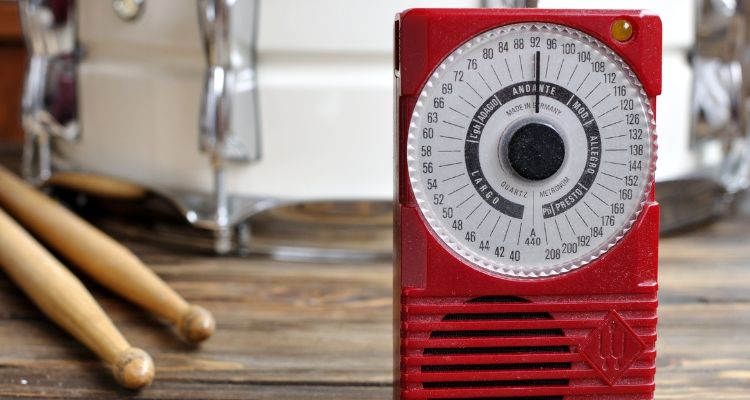
Another very important aspect of improving your drumming skills is doing metronome work.
The more you practice playing patterns and ideas with a metronome, the better your sense of timing will be.
So, this ties in with working on rudiments. You should use a metronome as much as possible when doing rudimental exercises. You should also use it while improvising and playing random patterns on a pad or practice pad setup.
A great way of learning how to play something new is by playing it repetitively at a very low BPM. Once your body gets used to playing that, bump the metronome tempo up slightly, but not by much.
If you do that for about an hour, you’ll get much faster without your body realizing that you’re getting faster. You develop excellent muscle memory with this method.
Pillows or Soft Surfaces
If you don’t have a practice pad, you could use a pillow to work on your rudiments. One of the benefits of using a pillow is that you get a lot of resistance. This helps work on wrist strength.
However, it’s not great for working on finger techniques. Some drummers swear by this method for getting faster, while others think it’s actually detrimental for your wrists. I’d suggest trying it out and deciding on your own whether you like to play on pillows or not.
Otherwise, you should just practice patterns on soft surfaces. Something like a carpet or blanket is soft enough to take the impact of your drumsticks. If you practice on very hard surfaces like floors, you get too much rebound. It also sounds irritating!
Body Percussion
Body percussion refers to when you use your hands and feet to play rhythms.
We all do this when we’re sitting and pretending to play drums to pass the time, but it can actually be quite effective as a practice method.
The best way of doing this is by listening and playing along to music. You can use your hands and feet to play grooves and fills, and most people end up having a great time while doing it.
Make sure to sit in a good position so that you can lift your leg and foot up to play bass drum patterns on the floor. You can then hit your thighs or chest with your hands.
Active Listening
Active listening is when you sit and listen to a song without any distractions. This means you shouldn’t tap your legs, play along on a pad, or air drum.
The point of active listening is to fully pay attention to a song and understand what’s happening in the music.
This is actually one of the best ways of practicing the drums without playing the drums. While your hands and feet won’t actually be doing anything, you’ll be getting a better understanding of songs that you want to play drums to.
This is what professional drummers do when they get setlists sent to them. They sit and listen to the songs very carefully before playing along. When you just play along to songs without listening to them, the chances are high that you’ll miss many parts that you should know about.
You can use active listening to understand song structures. All songs have verses, choruses, and bridges. While doing active listening, you can hear what the drum parts are meant to be doing in those different song sections.
You’ll then know what you need to practice when you actually get to a pad or drum kit. After actively listening through a few songs, you can then start tapping the drum parts on your legs.
Air Drumming
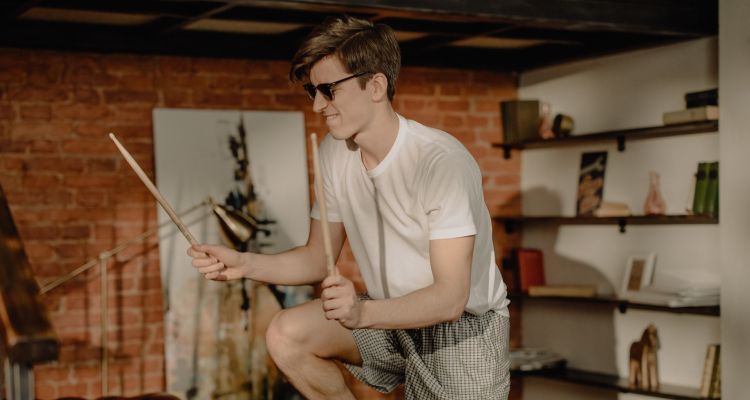
If you don’t want to hit yourself with your hands, you could also try air drumming. This method is far less effective, though.
Drumming is a physical activity, and you improve when your hands and feet actually make contact. Everyone gets a false sense of skill when they air drum.
With that being said, it’s a lot of fun to air drum along with your favorite songs, and it will most likely motivate you to get your practice pad out to practice.
Apps and Software
Something else that you can do to practice drums is using phone apps and computer software. There are a few virtual drumming apps that allow you to tap drum kit parts to create grooves.
You don’t get the same feeling as you get from using actual drumsticks, but it’s good to put ideas down so that you know how they sound.
You can then use notation software on a computer to write down different beats and fill ideas.
Doing this will get your drumming brain working, and you’ll start to get a better grip on how subdivisions and rhythms work together. Those skills will transfer over very nicely to a drum kit.
Virtual Drumsticks
There are a few brands that create drumsticks with sensors on them that allow you to get sounds while you air drum. The two popular brands I know of that make these are Aerodrums and Freedrum.
You get a pair of drumsticks, and then you sit as you would at a normal drum kit. When you hit the air with the sticks, you get matching sounds to where you would be hitting the normal kit.
I find these kinds of sticks to be a bit gimmicky, as you don’t get the same responsiveness that you get from practice pads or drum kits. However, they’re great fun to play with at times where you can’t access a kit.
Play Guitar or Piano
This last suggestion might seem a weird one, but playing another instrument like piano can often help you improve your drumming skills.
If you learn how to play an instrument that can play chords, you’ll start to understand music theory.
Knowing that will give you a better understanding of musicianship when you go back to playing drums.
Most of the best drummers in the world can play other instruments as well, and it’s the knowledge of how music is made that makes them better drummers.
How to Learn Drums Without a Drum Set
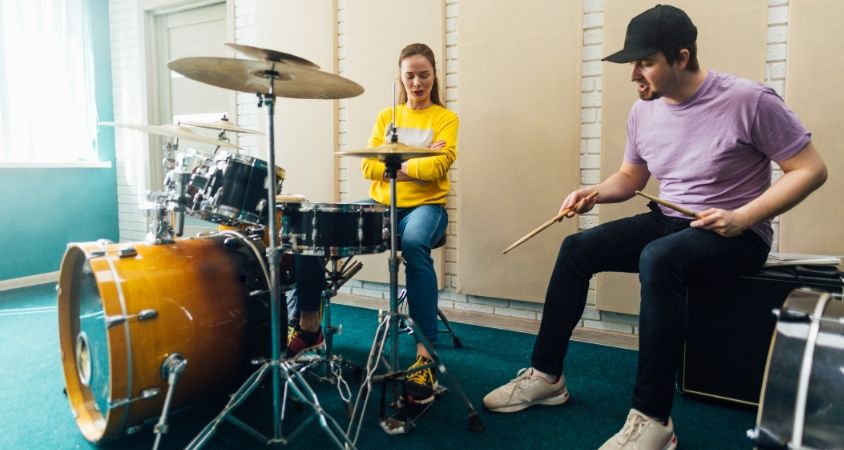
It’s not ideal to learn to play drums without a drum set, but it is possible. Drum kits are expensive and they are also loud, so it’s understandable to try drumming out before investing in a large set.
You won’t learn as quickly if you don’t have a drum kit at home to practice on, but there are a few things you can do to learn drums without actually owning any.
Attend Drum Lessons
The best thing you can do is to have in-person lessons with a drum teacher. Drum teachers will nearly all have their own teaching spaces.
The two benefits of going to a drum teacher’s space are that you get to play on a proper kit and that the teacher will give you good guidance with the starting steps.
If you try to learn to play drums on your own at home, you may get very confused with all the free information out there. While it’s great, most online drum lessons don’t offer valuable personal feedback.
Use All The Above Methods
When you’re at home and need to practice what you learned in your drum lessons, you should utilize all the methods that I mentioned above.
Out of all of them, the best step is to get a pair of drum sticks and a practice pad. You can then work on beginner hand techniques and rudiments.
Conclusion
As you can see from this guide, there are ways to practice drums without ever owning a drum set. I wouldn’t recommend doing it long-term, however.
You’ll see the most growth in your drumming when you sit at a kit and refine your skills. If you live in an apartment, you should aim to get an electronic drum set that will be a lot quieter than an acoustic one.

